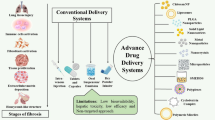Abstract
Heparin, cortisone, and combination of these two drugs were used for treatment of solitary tumors and artificial lung metastases of the fibrosarcoma NFSA and the mammary carcinoma MCA-K in C3Hf/Kam mice. Heparin reduced the number of artificial metastases of both tumors, but it did not affect the s.c. growth of these tumors. Conversely, cortisone reduced both the number of artificial metastases and the growth rate of s.c. tumors. The effect of cortisone was not further influenced by heparin. Cortisone showed a tendency for causing enhancement of spontaneous metastases. In addition, two heparin analogs, hexuronyl hexaminoglycan sulfates were studied against MCA-K solitary tumors and their spontaneous metastases. They were ineffective when given alone, and they did not influence the effect of cortisone on the s.c. tumor growth. However, they slightly reduced the cortisone-induced enhancement of spontaneous metastases.
Similar content being viewed by others
References
Acero, R., Polentarutti, N., Bottazzi, B., Alberti, S., Ricci, M. R., Bizzi, A., andMantovani, A., 1984, Effect of hydrocortisone on the macrophage content, growth and metastasis of transplanted murine tumors.International Journal of Cancer,33, 95–105.
Agosin, M., Christen, R., Badinez, O., Gasic, G., Neghme, A., Pizarro, I., andJarpa, A., 1952, Cortisone-induced metastasis of adenocarcinoma in mice.Proceedings of the Society of Experimental Biological Medicine,80, 128–131.
Ando, K., Hunter, N., andPeters, L. J., 1979, Immunologically nonspecific enhancement of artificial lung metastases in tumor-bearing mice.Cancer Immunology and Immunotherapy,6, 151–156.
Braunschweiger, P. G., Ting, H. L., andSchiffer, L. M., 1982, Receptor-dependent antiproliferative effects of corticosteroids in radiation-induced fibrosarcomas and implications for sequential therapy.Cancer Research,42, 1686–1691.
Denekamp, J., 1982, Endothelial cell proliferation as a novel approach to targeting tumor therapy.British Journal of Cancer,45, 136–139.
Folkman, J., Langer, R., Linhardt, R., Haudenschild, C., andTaylor, S., 1983, Angiogenesis inhibition and tumor regression caused by heparin or a heparin fragment in the presence of cortisone.Science,221, 719–725.
Folkman, J., Merler, E., Abernathy, C., andWilliams, G., 1971, Isolation of a tumor factor responsible for angiogenesis.Journal of Experimental Medicine,133, 275–288.
Gorelik, E., Bere, W. W., andHerberman, R. B., 1984, Role of NK cells in the antimetastatic effect of anticoagulant drugs.International Journal of Cancer,33, 87–94.
Hilgard, P., 1984, Anticoagulants and tumor growth: Pharmacological considerations.Cancer Invasion and Metastasis: Biologic and Therapeutic Aspects (New York: Raven Press), pp. 353–360.
Milas, L., Hunter, N., Basic, I., Mason, K., Grdina, D. J., andWithers, H. R., 1975, Nonspecific immunotherapy of murine solid tumors withCorynebacterium granulosum.Journal of the National Cancer Institute,54, 895–902.
Milas, L., Hunter, N. M., Ito, H., Brock, W. A., andPeters, L. J., 1985, Increase in radiosensitivity of lung micrometastases by hyperbaric oxygen.Clinical and Experimental Metastasis,3, 21–27.
Milas, L., Hunter, N., Mason, K., andWithers, H. R., 1974, Immunological resistance to pulmonary metastases in C3Hf/Bu mice bearing syngeneic fibrosarcoma of different sizes.Cancer Research,34, 61–71.
Penhaligon, M., andCamplejohn, R. S., 1985, Combination heparin plus cortisone treatment of two transplanted tumors in C3H/He mice.Journal of the National Cancer Institute,74, 869–873.
Rong, G. H.,Alessandri, G., andSindelar, W. F., 1985, Inhibition of tumor angiogenesis by hexyronyl hexaminoglycan sulfate.Cancer (in the press).
Author information
Authors and Affiliations
Rights and permissions
About this article
Cite this article
Milas, L., Hunter, N. & Basic, I. Treatment with cortisone plus heparin or hexuronyl hexoaminoglycan sulfates of murine tumors and their lung deposits. Clin Exp Metast 3, 247–255 (1985). https://doi.org/10.1007/BF01585080
Received:
Accepted:
Issue Date:
DOI: https://doi.org/10.1007/BF01585080




